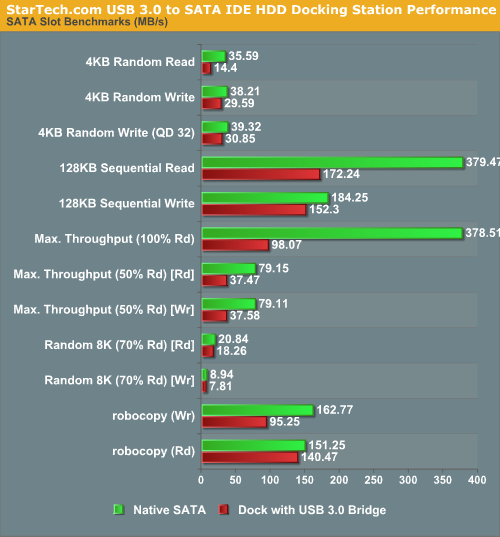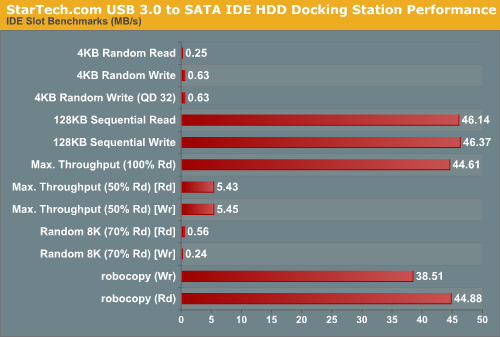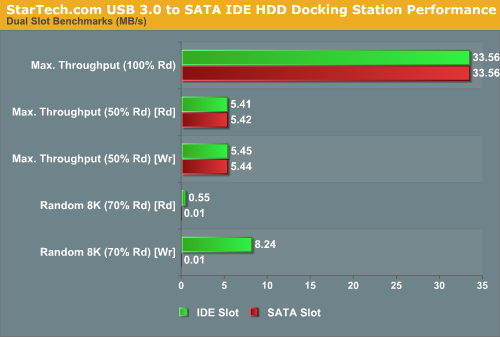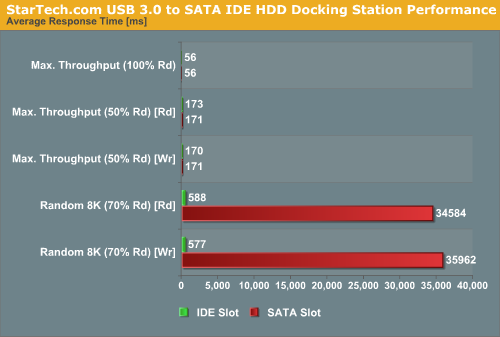StarTech.com USB 3.0 to SATA IDE HDD Docking Station Review
by Ganesh T S on June 18, 2012 1:30 PM ESTWe used two different approaches to benchmark the docking station. In order to get a quick idea of the capabilities of the unit, we used HD Tune Pro's benchmarks on both the Corsair Performance 3 SSD (connected through the SATA slot) as well as the Western Digital EIDE drive (connected to the IDE slot). After this, we shifted our focus to IOMeter and performed the four corners test (4KB Random Read / 4KB Random Write / 128KB Sequential Read / 128KB Sequential Write) as well as the disk performance bench (described here). First, let us take a look at the HD Tune Pro results.
The gallery below presents the various HD Tune Pro benchmarks performed on a raw drive connected to the SATA slot. The Corsair P3 128 GB SSD achieves an average of around 170 MBps and 150 MBps in sequential reads and writes respectively. Very small transfer sizes (such as 512B) bring about a large penalty, with speeds reducing to as low as 1.7 MBps reads and 4.2 MBps writes.
Moving on to the IDE slot, we repeated the above benchmarks. Sequential transfers benchmark around 17 MBps and 39 MBps for reads and writes. Small transfer sizes bring it down to 35 KBps and 55 KBps.
Our IOMeter benchmarks also present similar results. The graph below shows the SATA slot performance over USB 3.0. We also show the performance obtained by connecting the Corsair P3 SSD directly to one of the SATA 6 Gbps ports. In addition to the standard IOMeter tests, we also performed some robocopy benchmarks by transferring a Blu-ray folder structure of the HQV 2.0 Benchmark disc from local storage to the drive in the external dock and back to the local storage. Note that the robocopy benchmark speeds in the direct SATA case are probably held back by the speed of the local storage (a Kingston SSDVNow 128 GB SSD which doesn't have a SATA 6 Gbps controller).

Enabling Turbo mode in the Asus control utility did improve read performance a little bit, but actually made the write performance worse. Note that UASP is not supported.
| StarTech.com USB 3.0 SATA IDE HDD Docking Station [ SATA - USB 3.0 robocopy Benchmark ] | ||
| Operation | Bandwidth (Normal) | Bandwidth (Turbo) |
| Write | 95.25 MBps | 69.24 MBps |
| Read | 137.12 MBps | 150.59 MBps |
The IOMeter and robocopy tests were repeated on the IDE drive also. However, we didn't take the trouble to verify Normal vs. Turbo mode with the IDE drive.

We also tried simultaneous IOMeter benchmarks on both slots. While the unit is indeed capable of dual slot operation, we found that the IDE slot occupied the major time slots in the random workloads. The bandwidth and average response times in the graphs below shed more light.


We are not sure if the results are an indication of the way IOMeter operates, or it has something to do with the bridge controller. In any case, most scenarios involving dual slot operation should not involve too many random transfers and in that case, the bandwidth is shared equally between the two slots (and held back by the slower of the two).






















17 Comments
View All Comments
sheh - Tuesday, June 19, 2012 - link
Cables running to the back? What's the idea?FH123 - Tuesday, June 19, 2012 - link
Due to bad experiences with products like these, my first question would be more fundamental than the benchmarks: Does it work reliably? I've had multiple enclosures from Akasa which plain didn't. They consistently caused CRC errors when validating Ghost backups. This happened with multiple units on multiple machines with backups that were subsequently verified to be good, when the drive was put directly into a machine. As far as I recall I even tried different hard drives. In other words, I ruled out that it was anything but the enclosure as best I could. Did you validate data integrity or did you just take that as a given?I also own an older eSata version of the StarTech product you reviewed, but never really used it because of the pungent smell from of my particular unit, perhaps from the soldering job. Can you report on the smell of yours? No, I'm not kidding, the smell of mine is really strong and I swore off StarTech units as a result.
A still different adapter that I own, while mostly working fine, causes backups to hang every so often.
The common thread with many of these products seems to be JMicron chipsets. It seems impossible to avoid them. Ever since Anandtech reported on the JMicron issues with the first OCZ SSDs, of which I owned one, I've become weary of that company. My GigaByte motherboard works very reliably, except every now and then, after a boot, the mouse cursor locks up at regular intervals. This was improved, but not eliminated, by updating a JMicron driver for the PATA chipset in the machine.
ganeshts - Tuesday, June 19, 2012 - link
We do not take data integrity as a given. I have actually used the unit to back up a couple of IDE (40 GB) and SATA drives (256 GB SSD / 1 TB HDD) sector-by-sector using HDDGuru's Raw Copy Tool : http://hddguru.com/software/HDD-Raw-Copy-Tool/ : and I had no trouble mounting the copies as virtual drives and accessing the data as well as restoring it back to the drive using the same software / docking station.My review unit didn't have any specific smell, but I really can't vouch for every unit out there.
JMicron's chipsets are cheap and quite common. SSD controllers are a different beast because there is no single right way to perform the activities of a SSD controller. SATA and USB bridges are fairly straightforward and it is just a matter of implementing the specifications. Note that the IDE bridge in this product has been around since early 2004 and the USB3 bridge has been around since late 2009. Plenty of time for customers to report issues with the chipsets and get it fixed in a new tape out / firmware update.
Aikouka - Tuesday, June 19, 2012 - link
I own two USB 3 HDD docks (single drive only) from Vantec, and they work rather well. However, there's one small annoyance that I have with them... the drives will sometimes vibrate. Since I have mine positioned on top of my tower, the resonance with my case makes a rather annoying buzzing noise. I usually solve this by shoving something in the slot with the drive.Does this enclosure suffer from the same problem?
Also, what made you want to review this enclosure over the numerous other brands? I know when I was searching for a new USB 3 enclosure, I saw a few different brands. I'm also curious... I noticed the Apricorn self-powered USB 3 SATA adapter, and I was wondering how that compares to a powered adapter. I think Anand used one in a recent review.
What's amusing is that I considered buying it, but I shied away because I had never heard of the brand Apricorn before. I bought a Crucial M4 SSD with the transfer kit (the normal one went OOS). I like having spare adapters, so I didn't mind too much. Well, I opened the box to find... an Apricorn adapter. It actually works rather well so far with my old SSD, which makes me rather bummed that I passed on them so quickly.
ganeshts - Tuesday, June 19, 2012 - link
There is no specific vibration dampening mechanism, but I really didn't encounter anything out of the ordinary. (Every dock I have seen has some amount of vibration, and it actually depends on the drive being used).As for why this kit was reviewed, it basically depends on what product a company pitches to us at a given point in time (whether it is relevant to our readers / current coverage) and whether the editors have time to review the product at the time of pitching :)
If you want us to review any particular brands, let us know and we can always try to approach them for evaluation units.
Lerianis - Tuesday, June 19, 2012 - link
Even server farms have swapped them out. Sounds to me like it would have been better to have both slots SATA so you can use both of them for hard drives.vectorm12 - Tuesday, June 19, 2012 - link
In Sweden you can pick one of those up but instead of StarTech it's branded deltaco. Wonder if it's just some gadget that's been labeled god knows what or if it's the same company using different names.